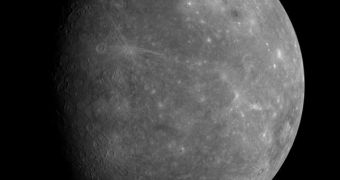The MESSENGER spacecraft made a successful fly-by of the planet Mercury last week, taking more than 1,200 pictures of the surface, some of them showing what seems to be evidence of past lava flows. Planetary scientist David Rothery said that the lava flow actually sits on top of the original surface crust that formed as the planet cooled, and could have occurred only after the massive number of impacts which rendered multiple craters to its surface had taken place, during the first half-billion years of the planet's life.
The massive amount of data collected as the probe passed only 27,000 kilometer over Mercury's surface will allow the astrophysicists to compare the lava flows to the surrounding surface crust, to get a better image of the process that took place inside it, well after the planet developed a solid crust. Similar methods have been used to study the Moon's past, by comparing the older crust formations with lava flows.
More than three decades ago, the spacecraft Mariner 10, sent to Mercury, had the mission of mapping and imaging its surface. Incredibly, although it was successful in collecting images representing about 45 percent of the planet's surface, the probe was unable to find similar features. Rothery reveals that one of the biggest concerns that appeared previously to the launch of the MESSENGER spacecraft was that it would not be able to make a difference between the planet's crust and lava flows.
The images also confirm one of the previous predictions related to Mercury. Some of the cliffs captured in the images present sharp edges and escarpment, which could have formed only as the planet cooled. The MESSENGER spacecraft will make a second fly-by around Mercury on 6 October, before a third one which will finally result in going into a stable orbit around the planet by the year 2011.
A similar mission will be sent by the European Space Agency in 2013. The BepiColumbo program represents a collaboration between the ESA and JAXA and will consist of two separate modules. The European MPO module will be build by Astrium, while the MMO module by JAXA. Both will enter stable orbits around the planet in 2019.

 14 DAY TRIAL //
14 DAY TRIAL //